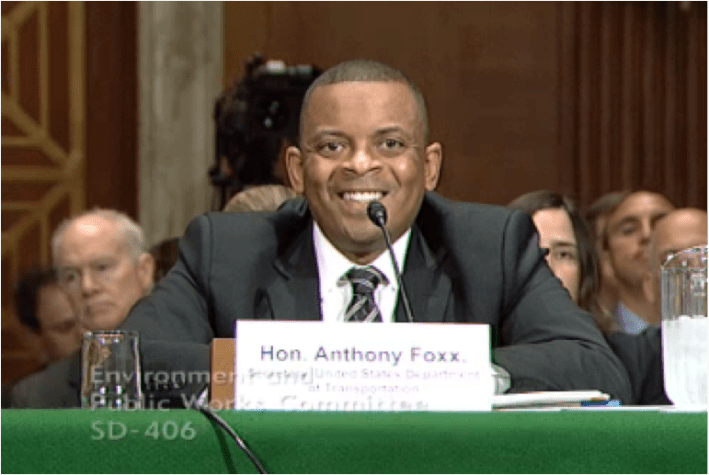Should the nation’s largest infrastructure loan program finance projects that make the transportation system more productive and efficient? Hell no, says Senator David Vitter, ranking member of the Senate Environment and Public Works Committee. Hundreds of millions of dollars should be available to any old project that comes along, as long as it has a good shot at repaying the loan.
It doesn’t make any sense, but MAP-21 changed the federal TIFIA loan program to award loans on a first-come, first-served basis. Credit-worthiness is the only remaining criterion. And at the same time that it removed all selection criteria, Congress increased funding for TIFIA nearly ten-fold -- a lot more money to throw at useless projects at a time when very few government programs are being expanded.
If you think it’s hard to stand up and defend the use of a billion dollars a year in taxpayer money on projects that may or may not have any public benefit -- think again. In an EPW hearing yesterday on U.S. DOT’s implementation of MAP-21’s TIFIA changes, Sen. David Vitter made it very clear that the quality of a given project must not have any bearing on whether that project is funded. In fact, he made it clear that a condition of expanding TIFIA was that the criteria be "simplified" in order to "get the program back to its original intent."
Some of us are a little concerned that in the DOT application, however, there is a new term in there: “public benefit,” asking for a description of “public benefit.” Why is that inserted in there? Because it’s not what we wanted to get back to: eligibility, either you’re in the box or not, either you’re eligible or not -- and credit worthiness. The concern is that something like public benefit obviously is completely subjective and would re-insert tremendous administration discretion, which quite frankly we didn’t want to do.
Anthony Foxx, the brand-new transportation secretary appearing in his very first Congressional hearing, said that to his knowledge, no applicant had been turned away because of concerns about public benefits. “In other words," he said, "every project that’s come through the doors, our staff is trying to work to get to ‘yes’ on those projects.”
But a few minutes later, Foxx made his way back to that issue, subtly standing up for the role the Transportation Department can play in actually making sure money is used well and projects actually serve a purpose. In a conversation with Senator Kirsten Gillibrand (D-NY) about private investment, he lauded the Chicago infrastructure bank for selecting projects “that will provide the best return -- but also the best public benefit.”
“And I think we should continue working towards that,” he said.
Foxx also noted that many transportation projects are worthwhile, even when they can't attract private sector financing. “While some projects are great candidates for public-private partnerships, there are some projects that are simply part of the public good -- and will never qualify for a public-private partnership -- but aren’t unimportant because of that,” he said.
That must have been reassuring for Sen. Ben Cardin (D-MD). In his opening remarks, Cardin cautioned against using TIFIA to build unnecessary new toll roads at the expense of other crucial investments.
“Many of the states that are utilizing TIFIA to build new roads have a long backlog of maintenance and repair of their existing roads,” Cardin said, noting that the nation has a $3 trillion repair backlog for bridges and highways. “So as we’re building new roads -- which is important -- we don’t have the funding to maintain existing roads. And I think we need to look at how we can put a priority on maintaining the safety of our existing transportation infrastructure. Because TIFIA’s not helping us with repair and maintenance.”
Cardin’s comments go to the heart of a chief critique of the TIFIA program: Because each project must generate a revenue stream, the loans simply aren’t available to projects that are, as Foxx said, “simply part of the public good.”
After all, as Cardin noted, 84 percent of TIFIA money goes to new highways. In his state of Maryland, where many constituents commute to downtown DC through some of the worst traffic congestion in the nation, highways aren’t the solution. “We need help on transit projects, and yet transit projects are having a difficult time getting TIFIA funding,” he said. Cardin added that the transportation appropriations bill the Senate was in the midst of debating doesn’t provide much hope for robust investments.
Senator Sheldon Whitehouse of Rhode Island said TIFIA wasn’t a good fit for his state, either. “I’m a big fan of the TIFIA program, but my Rhode Island director of transportation, Mike Lewis, tells me we’ve got nothing that qualifies for the TIFIA program,” Whitehouse said. “We’ve got plenty of highways that need to be repaired; we’ve got plenty of bridges that need to be repaired.” But TIFIA “simply doesn’t apply” in places that aren’t building new toll roads with revenue streams to pay back the loans and private investors.
Several transportation officials and industry representatives testified at the hearing that the process for TIFIA was too slow, having expanded so suddenly. Foxx said they were in the process of hiring 16 new personnel, which should help allay those concerns.
Happily for Foxx, his first hearing was a love-fest. Senator James Inhofe, until recently the top Republican on the panel and one of the Senate's most conservative members, greeted the new secretary with these words: “I can’t think of anyone who could have been nominated anywhere in America who is better qualified, or who would be easier to work with, than Secretary Foxx.”
And then Foxx proceeded to poke Inhofe, ever so gently, in the eye.
Just before Foxx was thanked and dismissed from the hearing, Inhofe reminded Foxx that he, too, is a former mayor (of Tulsa, Oklahoma). “Misery loves company,” Inhofe said. “There’s no harder job than being the mayor of a major city.”
He asked Foxx about his experience dealing with infrastructure matters as mayor of Charlotte, North Carolina, and Foxx proceeded to talk about the problems caused by sprawl and solved with transportation choices -- including bike paths, the object of Inhofe’s scorn. It was a stunning little speech, told extemporaneously at the tail end of his very first Congressional testimony.
Here’s what Foxx said about his experience as mayor:
In Charlotte we had gone through a period of about 30 years of dramatic sprawl expansion as a result of our ability to annex. And shortly after taking office it became very clear to me that we weren’t going to be able to annex any more, both because the laws had changed but also because we’d run out of land.
(Inhofe jumps in: “That’s exactly what happened to us; same situation.”)
And yet we were experiencing exponential population growth -- in fact, it was the fastest-growing metro region in country. And so our transportation systems have to do several things at once. It has to move things and people. It has to enhance the ability to make good land use choices. And it has to, hopefully, provide people with a reliable way to get someplace.
So for us it was highways, it was transit, it was bike paths and sidewalks, it was bridges. And when those things all work together well, what happens is that people have choices. And when they have choices, they feel empowered. And that is ultimately what transportation does for our country: It empowers people to have a good quality of life and have good jobs.
Could Ray LaHood have made a speech like that three weeks into the job?





